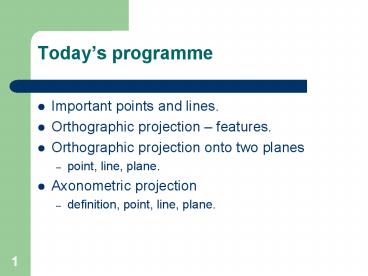Todays programme - PowerPoint PPT Presentation
1 / 21
Title:
Todays programme
Description:
Orthographic projection onto two planes. point, line, plane. Axonometric projection ... HW: Draw an unfoldment (development) of a part of the given prismatic surface ... – PowerPoint PPT presentation
Number of Views:53
Avg rating:3.0/5.0
Title: Todays programme
1
Todays programme
- Important points and lines.
- Orthographic projection features.
- Orthographic projection onto two planes
- point, line, plane.
- Axonometric projection
- definition, point, line, plane.
2
Line Plane
3
Important Points of a Line
- Trace points P, N, M.
- Pp?p(x,y) zP0
- Np?n(x,z) yN0
- Mp?m(y,z) xM0
4
Important Lines of a Plane
- Traces pa, na , ma
- pa a?p(x,y),
- na a?n(x,z),
- maa?m(y,z).
- Horizontal lines jh of a plane a are lines
parallel to p(x,y). - Frontal lines jf of a plane a are lines parallel
to n(x,z). - Third principal lines of a plane a are lines
parallel to ?(y,z).
5
Orthographic Projection - features
- Orthographic projection is a parallel projection
?It has all features of the parallel projection.
6
Preservation of the Right Angle
- Theorem
- Let a, b a pair of perpendicular straight lines
(neither of them perpendicular to ?). Projections
of a, b are perpendicular if and only if at least
one of the lines a, b is parallel to the image
plane.
7
Line Perpendicular to a Plane
- Theorem
- If a line k is perpendicular to a plane a then
- k1 is perpendicular to the trace p1a (and to all
horizontals jh1), - k2 is perpendicular to the trace n2a (and to all
frontals jf1).
8
Orthographic Projection onto Two Planes (Monge
Projection)
9
Monge Projection a point
2D projection of point A
- 3D - point A in space.
10
Monge Projection a line
2D projection of line p
- 3D - line p in space.
11
Monge Projection a plane
2D projection of plane ?
- 3D plane ? in space.
12
Monge Projection
- Ex1 Projection of a cube ABCDEFGH
- Ex2 Sketch projection of a cylinder, a cone, a
pyramid, a sphere in Monge projection.
13
Application of the principal lines
- HW Draw an unfoldment (development) of a part of
the given prismatic surface between ?(x,y) and
the given plane ?.
14
Axonometric Projection
15
Axonometry - definition
- Let S O OA, OB, OC be a Cartesian system of
coordinates in the space. Let (?,s) be a parallel
projection such that the projection of no axes is
a point. Images of the coordinate axes x, y, z
are three mutually different lines xa, ya, za
going through one common point Oa the image of
the origin O. Such projection is called
axonometric projection axonometry.
O origin OA, OB, OC unit segments on axes jx,
jy, jz axonometric units
? axonometric image plane s direction of
parallel projection
Unique determination of the axonometry by five
parameters jx, jy, jz, lt(x, z), lt(y, z)
16
Classification of the Axonomtery
- According to size of the axonometric units
- isometry jx jy jz
- dimetry jx jy or jz jy or jx jz
- trimetry jx? jy? jz
- According to direction of the projection
- orthographic
- oblique / general
17
Axonometry - uniqueness
- describes an 3D object in 2D by means of a pair
of parallel projections - 1) parallel projection of the object into r (that
is your sheet of paper) - 2) parallel projection of either the top view or
the front view or the side view of the object
into r
The coordinate system is ALWAYS projected
together with the object!
18
Axonometry of a Point
Unique representation of the point M M,M1,
MM1z or M,M2, MM2y or M,M3, MM3x.
- Real size of coordinates xM, yM, zM
- Axonometric units (distortion of units)
- jx, jy, jz
19
Axonometry of a Line
- Important points of a line trace points P, N,
M. - Pp?p(x,y) zP0
- Np?n(x,z) yN0
- Mp?m(y,z) xM0
- Unique representation
- of the line p
- p,p1 or
- p,p2 or
- p,p3.
20
Axonometry of a Plane
- Traces pa, na, ma
- pa a?p(x,y),
- na a?n(x,z),
- maa?m(y,z).
Traces pa, na, ma intersect on the coordinate
axes or each two are parallel.
Parallel planes have parallel traces.
21
Next time
- oblique projection.































